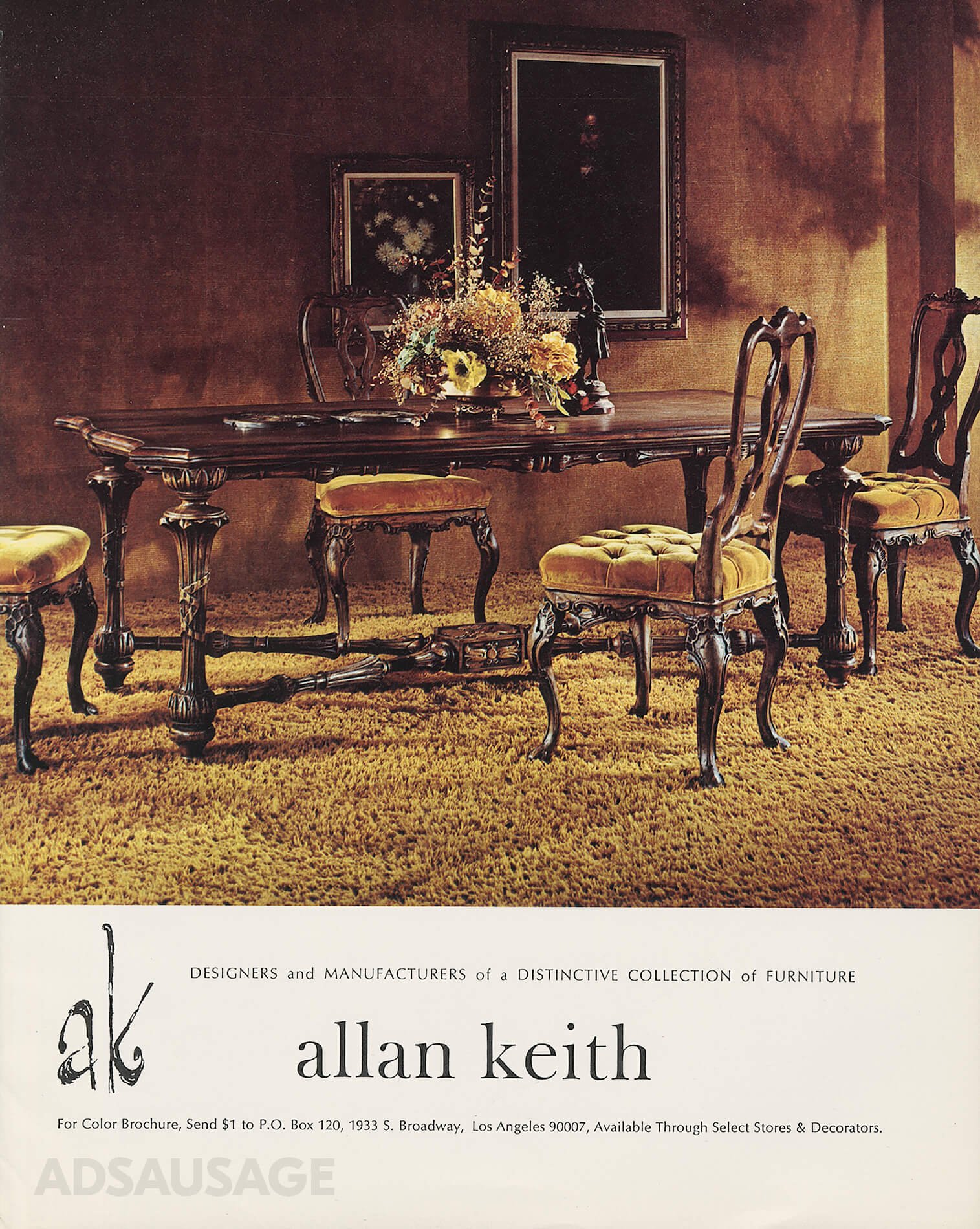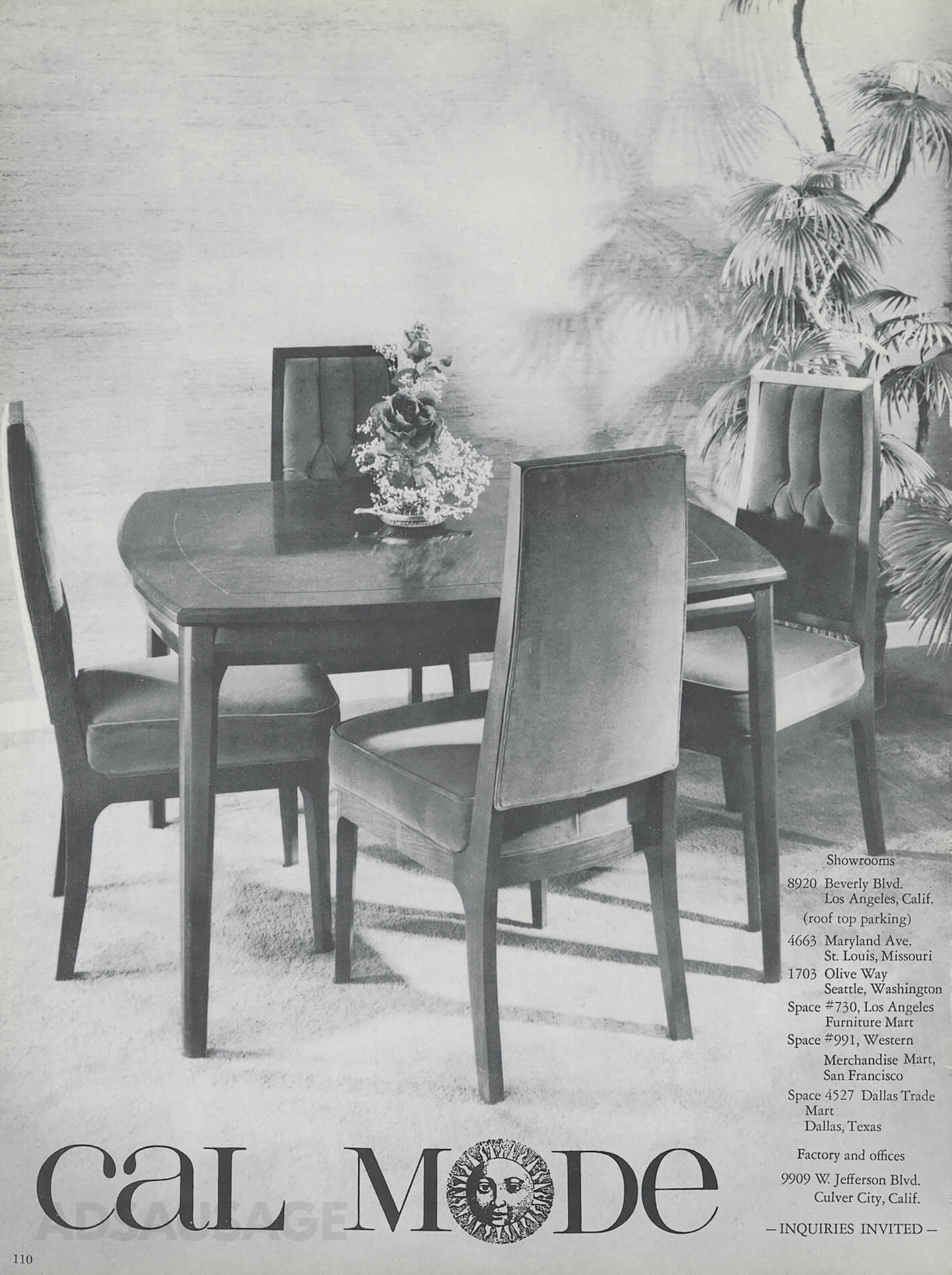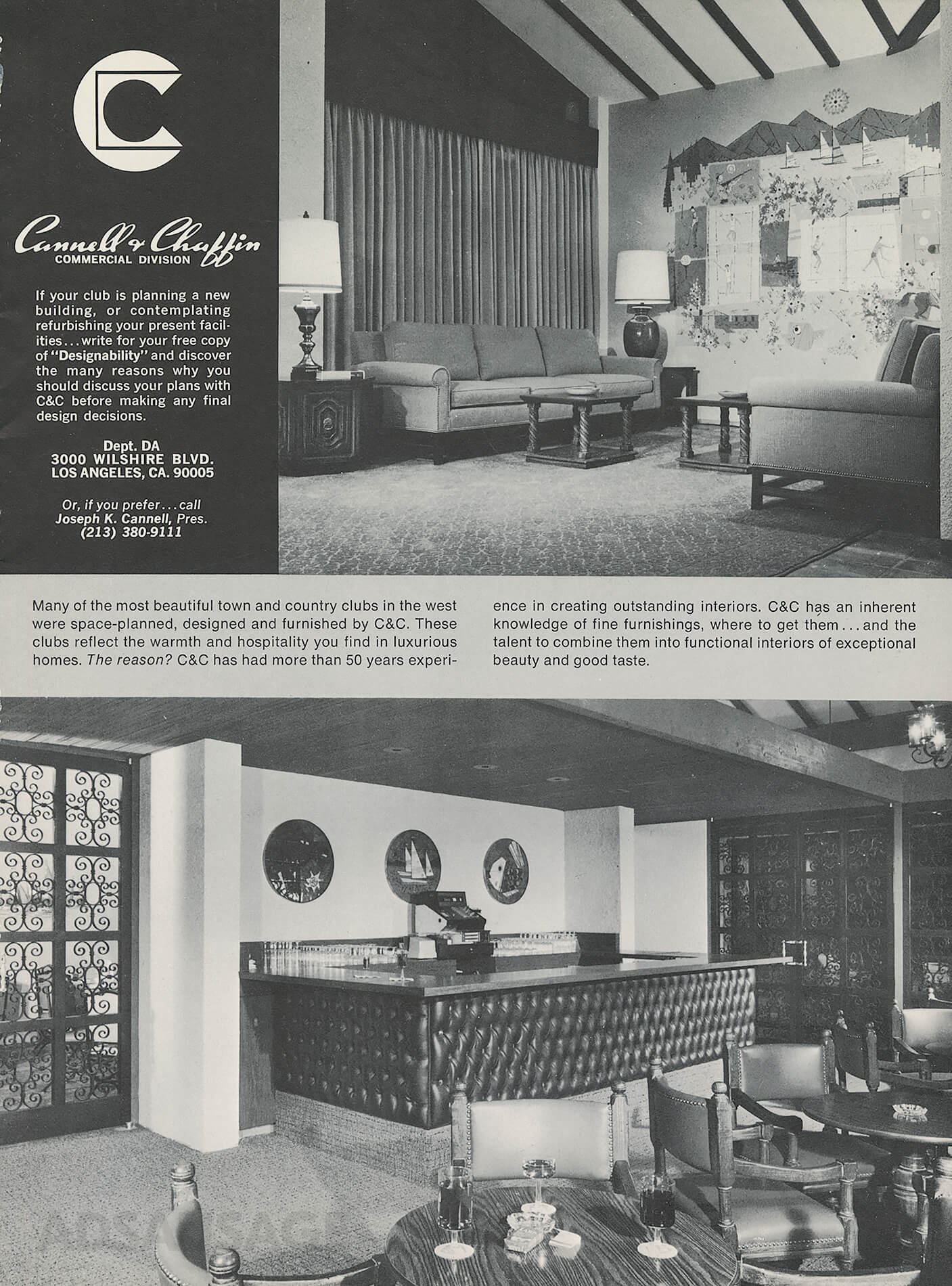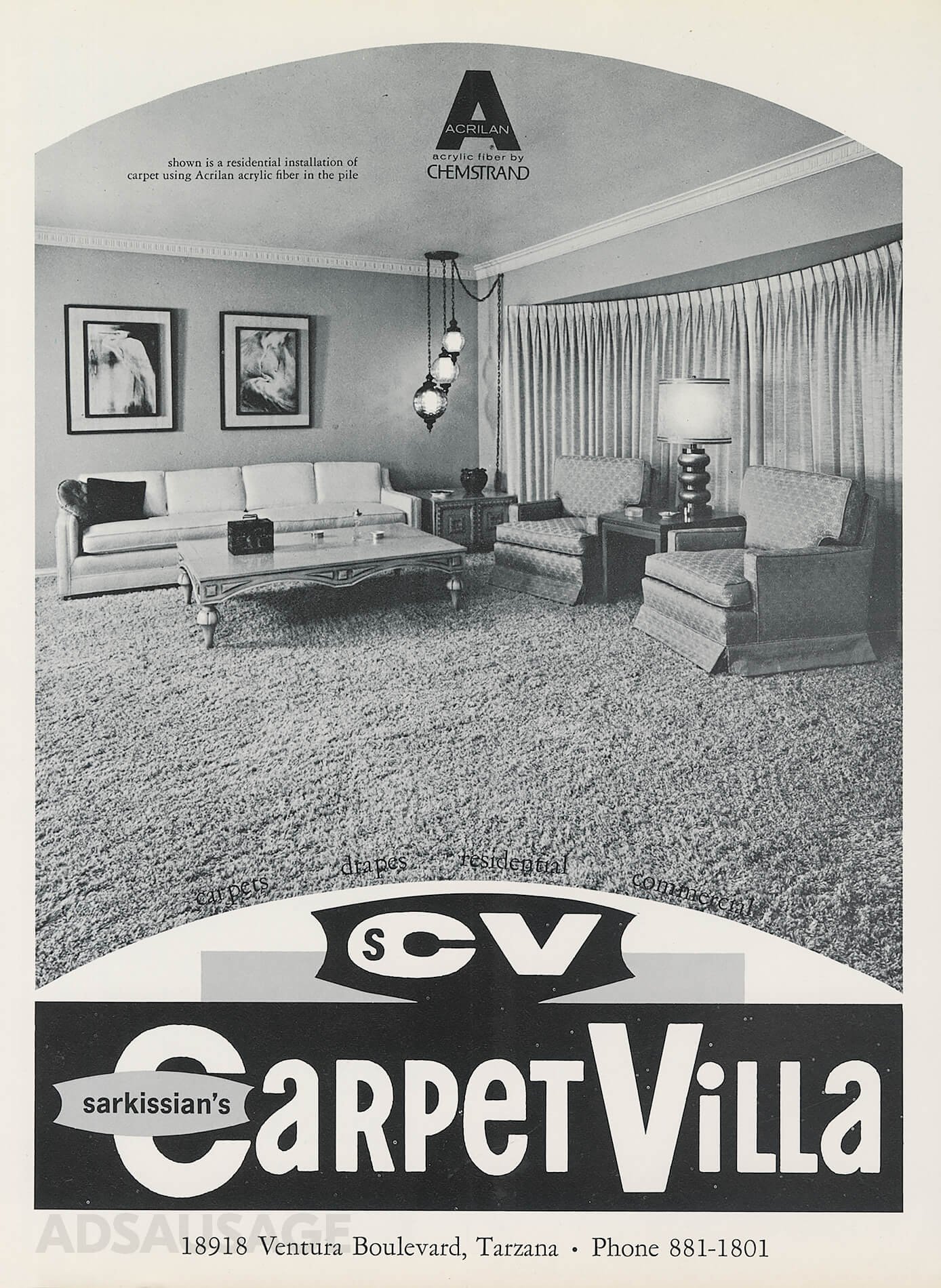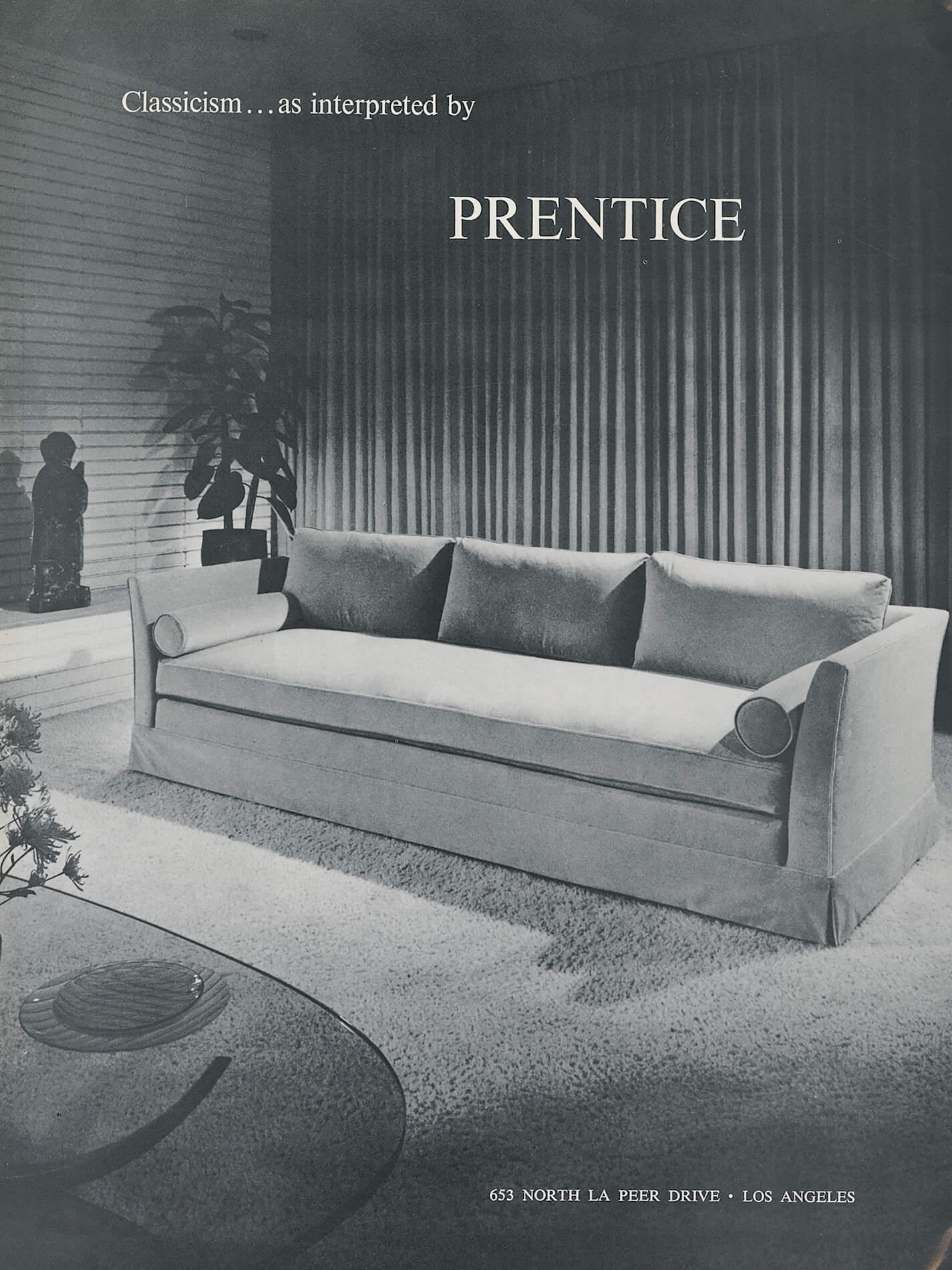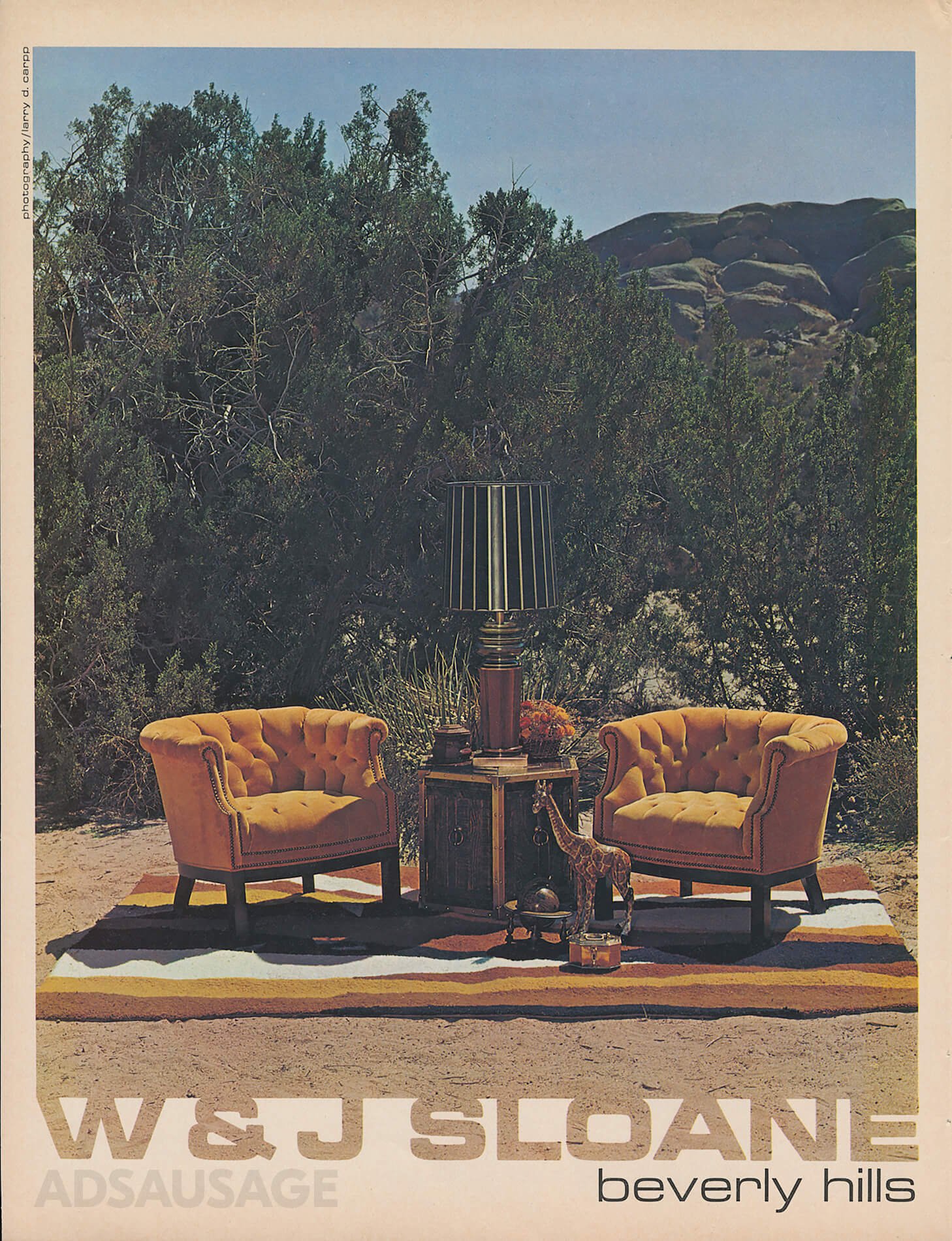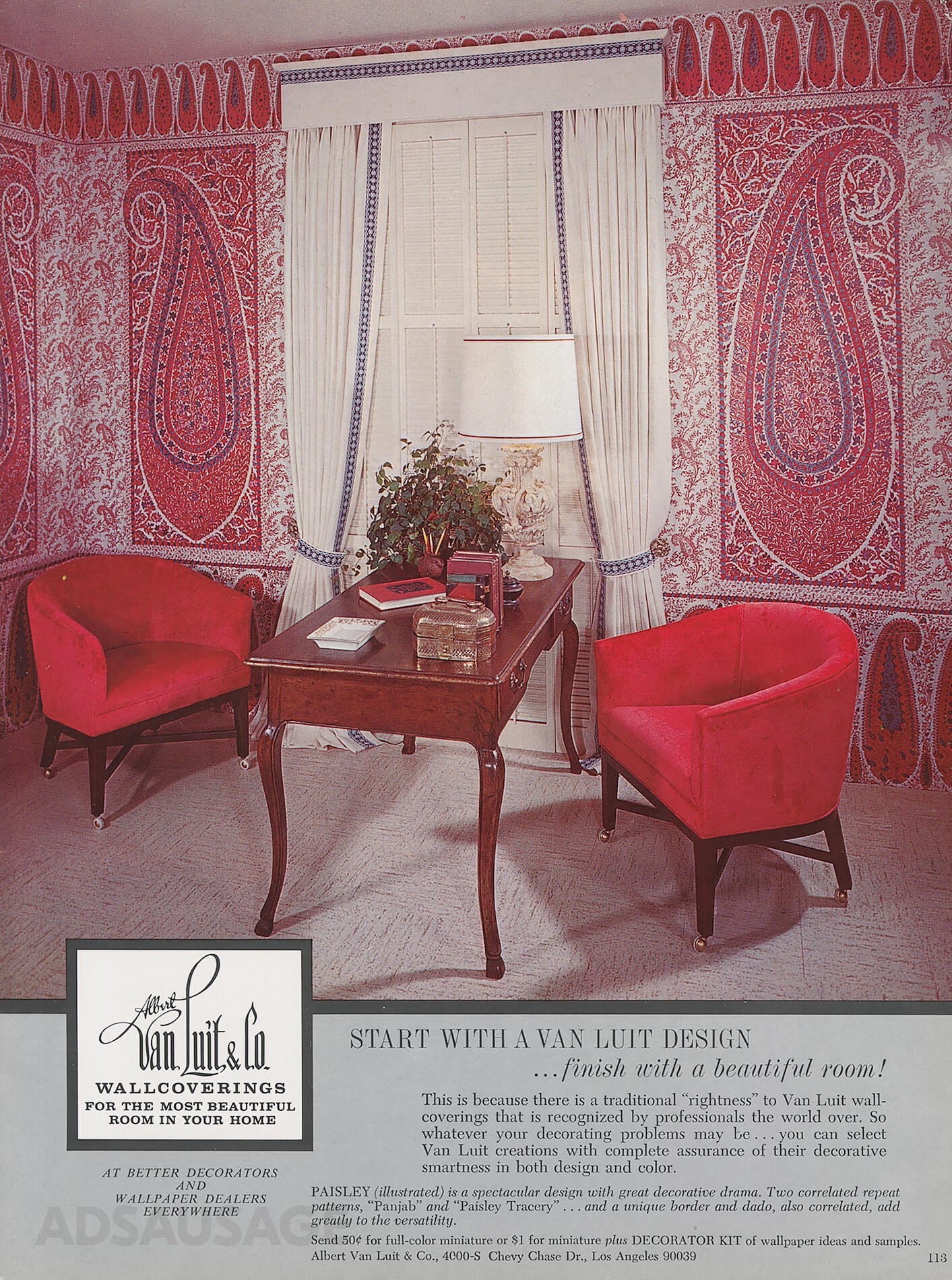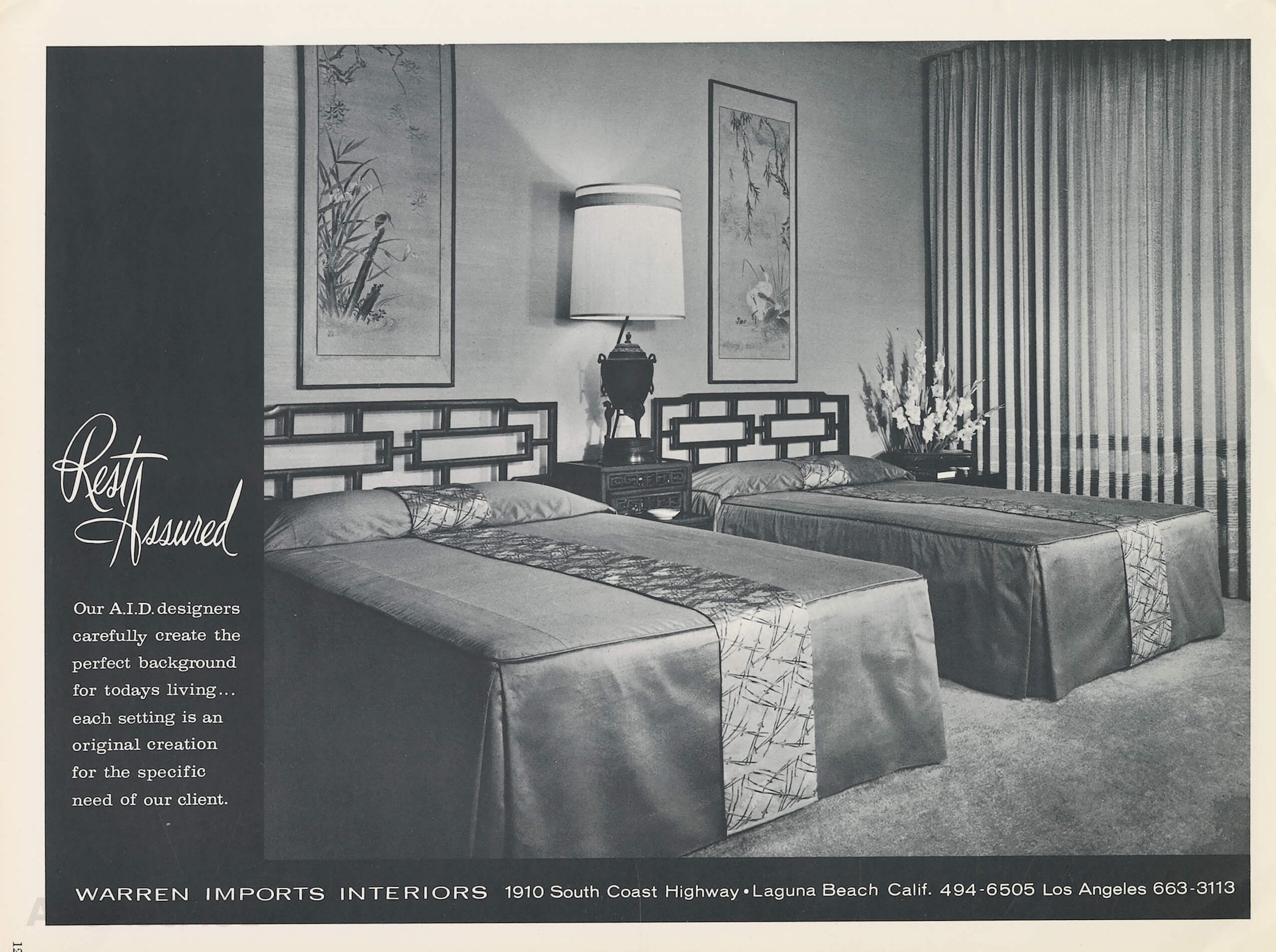Vintage Interior Design
1966 - 1970
Culled from a variety of design magazines, I’ve curated a ravishing archive of home decor — from the bedroom to the bathroom. Over one hundred images in glorious color. The kind of places you’d expect Neely O’ Hara and Matt Helm to meet for cocktails and quaaludes.
To begin, I’m tipping my hat to a few (mostly) Los Angeles-based designers.
Atlas Shutter | Barnett Bros. | Brunschwig & Fils | Cal Mode | Cannell & Chaffin | Carpet Villa | Clifford Radford | E.C. Bondy | Eddie Eagan Hannah Grover | Kathryn Crawford | Leslie Interiors | Master Cabinet Merrel Richards | Montiverdi Young | Prentice | Ritts Co. | Robert Crowder
Rode Bros. | W&J Sloane | Taylors Interiors | Van Luit | Warren Imports
Allan Keith
Barnett. Bros
Founded in the late-1950s, the family business was run by Mervyn Barnett (originally a decorator) and his younger brother Albert. Head of the family was Irving Barnett who owned Southwest Carpet Company, located on Crenshaw Blvd.
The carpet company segued into interior decorating and outfitted homes. hotels and restaurants. Among the clientele were Gene Raymond and Jean Harlow, as well as the Mona Lisa restaurant on Wilshire.
In the mid-1960s, the successful firm coordinated its designs in a number of buildings including; the County Museum of Art, the Wilshire Ardmore in Westwood, Sierra Tower in West Hollywood, the Los Feliz Towers, the Baldwin Hills Estates, and the Encino Spa Condominium.
Mervyn Barnett passed away in 1995.
Brunschwig & Fils
Dating back to the 1800s, the French firm originated with tapestries. Led by Colonel Roger Brunschwig and his wife Zelina (known as the grande dame of high-fashion fabrics), the New York-based company made a name for themselves importing “Documents” — fragments of old fabrics; linen, silk, velvet, and cotton.
Much of their work was exhibited in 1965 at the A.I.D. Interior Design Show which was held in the Sports Arena.
Cal Mode
Founded by James Rifkin (d. 1984) in the early 1950s, the company occupied space on Beverly Blvd in 1963. The building was designed by the architecture firm of Mayer and Kanner. Among their designers was Conrad Divine of Dignity Group.
The family business moved to the Pacific Design Center in 1990 but was out of business by the end of the decade.
Cannell & Chaffin
Founded by S. Bartley Cannell Sr. and George Chafin, the firm was later operated by their sons. Among their clients was William Randolph Heart, who enlisted the pair for a project at La Casa Grande, as well as the private San Clemente residence of Mr. and Mrs. Nixon.
Known for high-end items, Cannell & Chaffin’s original location was a gallery in downtown Los Angeles at 720 West 7th. They moved to Wilshire Blvd in 1930 and expanded with locations in Pasadena and Westwood in the early-1950s. Designed by Roland Crawford, the Westwood building is currently home to apartments.
The company sued actor John Barrymore in 1940 for money owed on furniture, draperies, and rugs. A sheriff was sent to the Bellagio Road home but was greeted by the actors’ mother-in-law who informed the deputy the furniture finaglers were “somewhere in the East.”
They relocated again in the early 1970s to 7th and Hoover, where they remained until filing for bankruptcy in 1987.
Joseph Knapp Cannell (father of successful TV writer Stephen Joseph) passed away in 1995.
Carpet Villa
Anyone looking for tight-woven texture or perhaps a deep springy pile would be satisfied at Carpet Villa in Tarzana. In business since 1947, Carpet Villa was operated by Parkev and Carlos Sarkissian.
Not just a baron of broadloom, Parkev formerly managed Baloyan Mills in Van Nuys and served as a deacon at the St. Peter Armenian Apostolic Church in Sherman Oaks. In 1968, the chieftain of cut pile operated Empire Carpet Mills in Woodland Hills.
Clifford Radford & Sons
E. C. Bondy
Known as the “Southland’s Leading Wallpaper House”, E.C. Bondy began operating in the late 1940s with a showroom in Beverly Hills (later home to the Gering Galleries). They went out of business in 1975.
Named for Emile Bondy of New York? Bondy and Lederer Cigar Company
Eddie Eagan & Associates
Nothing to do with The French Connection — just quality flooring.
Hannah Grover
Century Park East, Bunker Hill Towers, Wilshire Comstock. In 1967, the designer operated her interior design firm from the 11-unit Regency House on Doheny. Previous tenants included Mickey Hargitay.
Collaborated with the Boysen Paint company offering customers design tips.
Kathryn Crawford
The former actress and husband of Ralph M. Parsons (d. 1974), entered interior design after her film career ended in the 1940s. Among her early designs were custom lampshades which were sold at W&J Sloane in Beverly Hills.
Crawford converted the manager’s office into a private suite at the Hollywood Palladium for Princess Margaret and Lord Snowden in 1965, as well as apartments for Barron Hilton, General Douglas MacArthur, and President Herbert Hoover.
She was the consulting designer for Mary Pickford’s Pickfair Estate for over twenty years and worked with the actress and her husband Buddy Rogers on their Palm Springs vacation home in the late 1950s.
Kathryn Crawford Parsons passed away in 1980 at the age of 72.
Leslie's Interiors
Starting in the late 1950s, Leslie’s Interiors operated a showroom on Wilshire Blvd. — now the site of the Wilshire/Vermont Metro station. The contemporary furniture store later opened at 3rd and Fairfax (which doubled as gallery space in 1962 before becoming E. Brunner Interiors two years later). The company survived until the late 1970s.
Master Cabinet
Merrel Richards and Associates
Operated by Merrel Richard Gossman, the firm began in Northridge in 1963.
Montiverdi-Young
Founded by Angelo F. Montiverdi in the mid-1930s, the makers of office and residential furniture opened their West Hollywood showroom in 1959. The corner spot became Chairs Unlimited in 1967.
Prentice
Owner Joseph Brunstein opened the Prentice showroom in West Hollywood in 1956. The new facility was designed by architect J. H. Kuhl & Sons. The building was later considered a new home for the West Hollywood City Hall
Ritts Co.
Their West Hollywood furniture showroom achieved global fame in the 1987 movie Lethal Weapon when the space doubled as the location for an out-of-business store. A slightly unhinged and sweaty Mel Gibson screamed at an exasperated Danny Glover “What do you wanna hear man… do you wanna hear that sometimes I think about eating a bullet?!”
The question was clearly rhetorical as the answer was in fact, he did — every single day… special ones for the occasion. Hollow-point.
Founded by Herbert Ritts in the early 1940s, Ritts Sr. operated Modern Rattan Furniture on Beverly Blvd. After a stint in the army, the former Air Force Sergeant turned designer exhibited his collections at various trade fairs and opened Ritts Co. in West Hollywood around 1950. They soon expanded with a location in Pasadena.
From a factory on South Sepulveda in West Los Angeles, Ritts began producing everything from Ranch style to tropical and Oriental pieces with names like; Tropitan, Mikado, Japanoma, Waikiki, and Chow Chow Set.
The company continued into the mid-1970s with Herbert’s ex-wife and interior designer Shirley and manufactured new lines with Astrolite, a spacecraft material.
After Ritts Co. departed their West Hollywood showroom in 1970, Eileeen and Norman Kreiss opened their import shop — Kreiss Ports of Call. Designed by architect Harry Harrison in 1947, the corner building has suffered multiple alterations.
The son of jeweler Joseph Rittigstein (d. 1958), Herb Ritts, Sr., and his wife Shirley had four children — the eldest was Herb Ritts (1952 - 2002) who became a renowned celebrity photographer.
Robert Crowder & Associates
Robert Crowder had lived in Japan for a number of years where studied Nihonga and taught at Kyoto University. The printmaker started the business with partner Bernard Gelbort in the late 1940s. The mural company specialized in Oriental art and worked on projects for Bullock’s in Pasadena, the Palmetto Room at Bullock’s downtown Los Angeles, and actress Gene Tierney.
After expanding with handwoven fabrics, the pair opened a small shop on Robertson Blvd and later moved to Melrose Place.
Although Crowder passed away in 2010, the company continues.
Rode Bros.
Founded by Arthur and Walter Rode in the mid-1930s, the company operated from their home on Berendo Street, before moving to Melrose Avenue in the 1950s (which survived until 1969). The company is still in business.
W&J Sloane
Founded by Scottish-born William Sloane in 1843, the home furnishings store began with a location in San Francisco and entered the Southland with a store at Broadway and 7th in downtown Los Angeles (taking over the California Furniture Company).
In 1936, Sloane opened its first Beverly Hills location at 9536 Wilshire, later moving to 9560 Wilshire. Designed by architect Paul R. Williams in 1950, the impressive six-story corner building was decorated in white heather and Scotch plaid — reportedly flown in from the land of bagpipes, haggis, and Billy Connolly.
Among the building’s many innovations was elevator window displays that disappeared into the basement for a hasty re-dressing, a model home on the fifth floor, and underground parking for 150 vehicles.
Things fell apart in 1969 after merging with New York-based retailer Beck Industries (formerly A.S. Beck Shoe Industries). Led by 35-year-old Chuck McDevitt (d. 2021), the company was looking to build a base of “retail fashion merchandising” and looked for firms that were “very well run or very poorly run”.
Soon after the W&J Sloane acquisition, parent firm Beck Industries filed for Chapter 10 bankruptcy owing to a massive debt load and a slowing economy. Around this time, the American Stock Exchange was also investigating the firm and McDevitt departed in 1970.
In addition to acquiring W&J Sloane, the purchasing spree included; Angelus Furniture, Judy’s, and discount store Disco Fair (in spaces formerly occupied by Unimart).
Beck had previously acquired Valentino of Rome for a reported $4M, its first foray into high fashion.
With the veteran store now struggling, the building’s lease was sold, and by 1982, Sloane closed for a massive liquidation sale. In a strange twist, Angelus Furniture (opened by Harry Siskin in 1901) was back in business by 1980, having bought inventory from W&J Sloane and opened a new warehouse in East Los Angeles.
The Beverly Hills building was also the West Coast headquarters of investment bank Drexel Burnham Lambert.
After the demise of W&J Sloane, the 122-year-old furniture and accessories store Gump's put up their famous red awning and remained there for the next decade. In spite of opposition, Planet Hollywood took over in 1995. Despite overpriced hamburgers and a chance to win tickets to see Billy Crystal in My Giant, the celebrity-backed eatery filed its first bankruptcy in 2000.
In recent years, the old W&J Sloane building was home to Niketown and Burberry.
Taylor's Interiors
A family business since 1940, Taylor’s operated locations in Reseda (“for Continental elegance”), Canoga Park, and Van Nuys — which opened in 1956 on the former Van Nuys Furniture Mart, and survived until 1991. The site is currently a swap meet.
Van Luit
Known for murals and hand-printed scenic wallpapers, the company was headed by Cleveland-born Albert Van Luit. The one-time resident of Laguna Beach began in 1937, working from a garage in Hollywood with Joseph Cannell and North Baker.
Van Luit later moved to Glendale and maintained his successful business until his death in 1970. The company was acquired by mattress firm Simmons in 1977.







